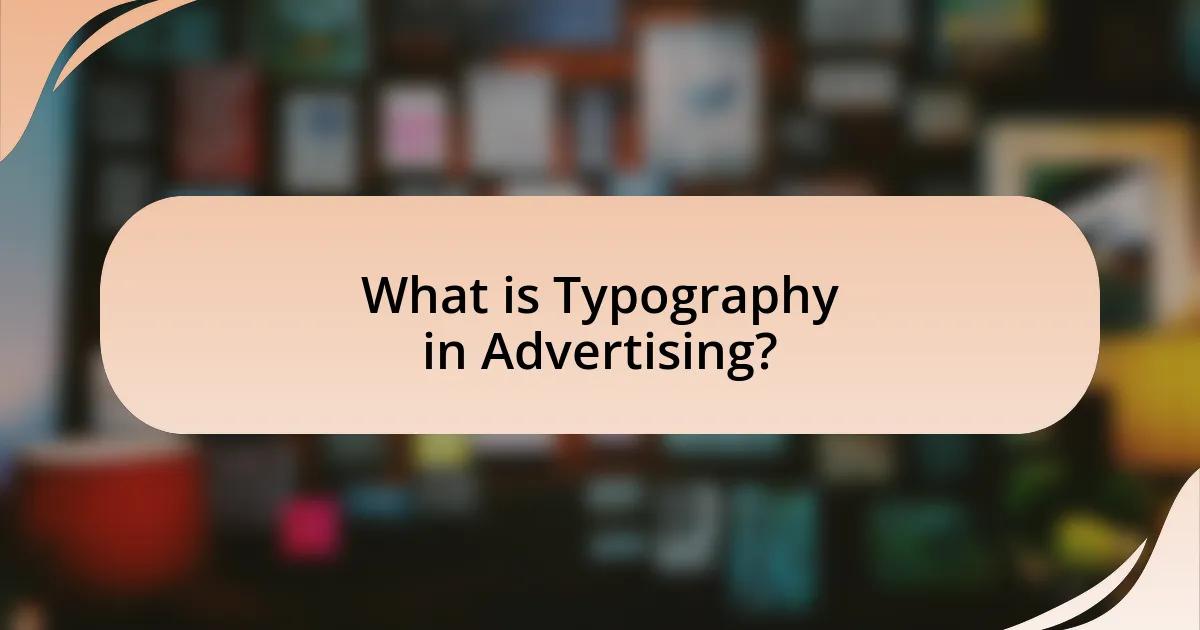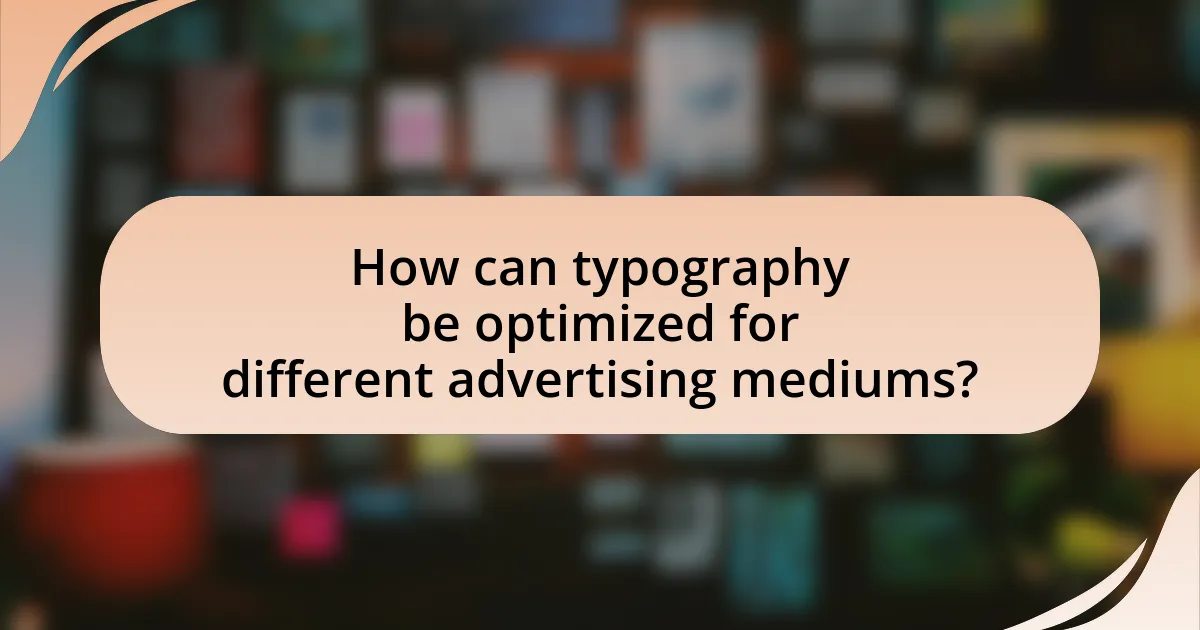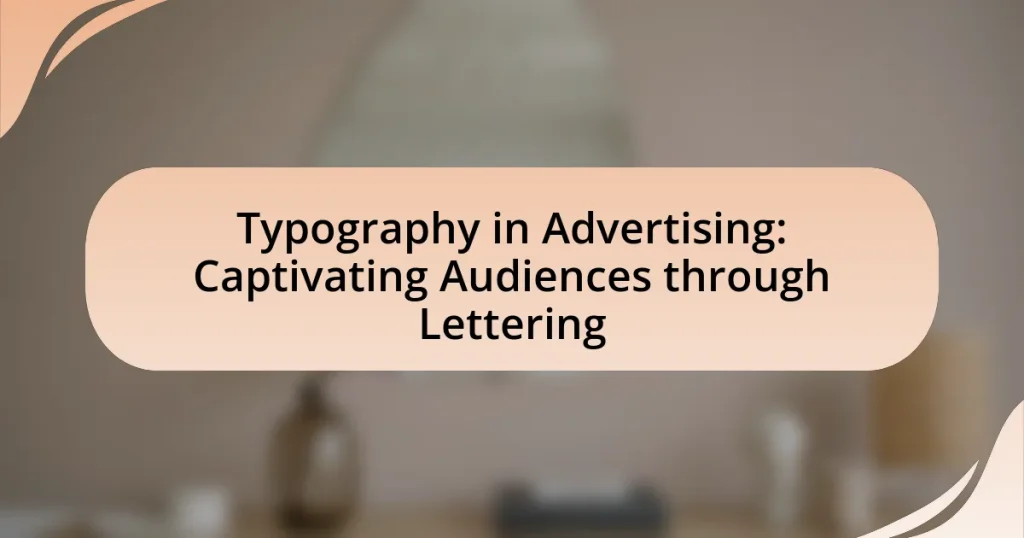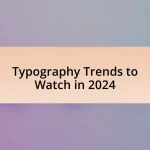Typography in advertising is the art and technique of arranging type to enhance legibility, readability, and visual appeal in promotional materials. This article explores how typography influences consumer perception, brand identity, and message clarity, emphasizing its psychological effects and the importance of font choices. Key elements of effective typography, including legibility, hierarchy, and consistency, are discussed alongside best practices for optimizing typography across various advertising mediums. Additionally, the article examines the interaction between typography and other design elements, highlighting common mistakes to avoid and tools that can aid in effective typography implementation.

What is Typography in Advertising?
Typography in advertising refers to the art and technique of arranging type to make written language legible, readable, and visually appealing in promotional materials. Effective typography enhances brand identity, influences consumer perception, and drives engagement by utilizing font styles, sizes, spacing, and color to convey messages clearly and attractively. Research indicates that 95% of a message’s first impression is based on visual appearance, underscoring the importance of typography in capturing audience attention and conveying brand values effectively.
How does typography influence consumer perception?
Typography significantly influences consumer perception by affecting readability, emotional response, and brand identity. Research indicates that different typefaces can evoke specific feelings; for instance, serif fonts often convey tradition and reliability, while sans-serif fonts are perceived as modern and clean. A study published in the Journal of Consumer Research found that consumers are more likely to trust brands that use fonts they find aesthetically pleasing, demonstrating that typography can directly impact purchasing decisions. Additionally, consistent typography across marketing materials strengthens brand recognition, as consumers associate specific fonts with particular brands, enhancing their overall perception and loyalty.
What are the psychological effects of different typefaces?
Different typefaces evoke distinct psychological effects that influence perception and behavior. For instance, serif typefaces, such as Times New Roman, are often associated with tradition, reliability, and professionalism, making them suitable for formal contexts like legal documents. In contrast, sans-serif typefaces, like Arial, convey modernity and simplicity, which can enhance readability and are frequently used in digital media.
Research by the University of Reading found that typefaces can significantly affect the perceived credibility of information; for example, a study indicated that people rated information presented in serif fonts as more trustworthy than that in sans-serif fonts. Additionally, decorative typefaces, such as Comic Sans, may evoke feelings of playfulness but can also be perceived as unprofessional, impacting the seriousness of the message conveyed.
Overall, the choice of typeface plays a crucial role in shaping audience emotions and attitudes, influencing their engagement with the content.
How does typography contribute to brand identity?
Typography significantly contributes to brand identity by establishing visual consistency and conveying the brand’s personality. The choice of typeface, size, spacing, and color can evoke specific emotions and associations, helping to differentiate a brand in a crowded market. For instance, a study by the University of Reading found that typeface can influence consumer perception, with serif fonts often perceived as more trustworthy and modern sans-serif fonts associated with a more contemporary feel. This alignment of typography with brand values enhances recognition and recall, ultimately reinforcing the brand’s identity in the minds of consumers.
Why is typography important in advertising campaigns?
Typography is important in advertising campaigns because it significantly influences consumer perception and engagement. The choice of typeface, size, and spacing can evoke emotions, convey brand identity, and enhance readability, ultimately affecting the effectiveness of the message. Research indicates that 95% of a message’s impact is determined by its visual presentation, including typography, which underscores its critical role in capturing attention and driving consumer action.
What role does typography play in message clarity?
Typography significantly enhances message clarity by influencing how text is perceived and understood. The choice of font, size, spacing, and color can either facilitate or hinder readability, directly impacting the audience’s ability to grasp the intended message. Research indicates that well-designed typography can improve comprehension by up to 30%, as it aids in guiding the reader’s eye and emphasizing key information. For instance, studies have shown that sans-serif fonts are often easier to read on digital screens, while serif fonts can enhance readability in print. Therefore, effective typography is crucial in ensuring that messages are communicated clearly and efficiently in advertising contexts.
How can typography enhance visual storytelling?
Typography enhances visual storytelling by conveying emotions and setting the tone of the narrative. The choice of typeface, size, and spacing can evoke specific feelings; for instance, a bold sans-serif font may communicate strength and modernity, while a delicate script font can suggest elegance and nostalgia. Research indicates that 90% of information transmitted to the brain is visual, and typography plays a crucial role in this visual communication by guiding the viewer’s attention and influencing their perception of the message. Effective typography not only complements the imagery but also reinforces the overall story, making it more engaging and memorable for the audience.

What are the key elements of effective typography in advertising?
The key elements of effective typography in advertising include legibility, hierarchy, alignment, contrast, and consistency. Legibility ensures that the text is easy to read, which is crucial for conveying the message quickly; for instance, studies show that sans-serif fonts are often more legible on screens. Hierarchy guides the viewer’s attention by using different font sizes and weights to emphasize important information, helping to structure the content effectively. Alignment creates a clean and organized appearance, enhancing the overall aesthetic and readability of the advertisement. Contrast, achieved through color and font weight differences, helps important elements stand out, making them more noticeable. Lastly, consistency in typography across various advertising materials reinforces brand identity and fosters recognition, as seen in successful campaigns that maintain uniform font styles and sizes.
How do font choices impact advertising effectiveness?
Font choices significantly impact advertising effectiveness by influencing readability, brand perception, and emotional response. Research indicates that fonts can affect consumer behavior; for instance, a study published in the Journal of Consumer Research found that serif fonts are often perceived as more trustworthy, while sans-serif fonts are associated with modernity and cleanliness. Additionally, the choice of font can enhance or detract from the message being conveyed, as specific styles can evoke particular emotions. For example, playful fonts may attract a younger audience, while elegant fonts may appeal to a more sophisticated demographic. Thus, the strategic selection of fonts in advertising can enhance engagement and drive consumer action.
What are the characteristics of legible fonts?
Legible fonts possess distinct characteristics that enhance readability. Key features include clear letterforms, appropriate spacing between characters and lines, and a balanced contrast between thick and thin strokes. Research indicates that fonts with a larger x-height, such as Arial or Helvetica, improve legibility, especially at smaller sizes. Additionally, sans-serif fonts are often preferred for digital displays due to their simplicity and clarity. Studies have shown that fonts designed with these principles can significantly reduce reading time and increase comprehension, making them effective for advertising purposes.
How does font size affect readability and engagement?
Font size significantly affects readability and engagement by influencing how easily text can be processed by the reader. Larger font sizes enhance readability, making it easier for individuals to scan and comprehend content quickly, which is crucial in advertising where capturing attention is essential. Research indicates that text set in a font size of 12 to 14 points is generally optimal for readability in print, while digital content often benefits from larger sizes, around 16 pixels or more, to accommodate various screen resolutions and user preferences. Studies have shown that increasing font size can lead to higher engagement rates, as users are more likely to interact with content that is visually accessible. For instance, a study published in the International Journal of Human-Computer Studies found that larger text sizes improved user engagement metrics, such as time spent on a page and click-through rates, confirming the importance of font size in effective typography for advertising.
What are the different types of typography used in advertising?
The different types of typography used in advertising include serif, sans-serif, script, display, and monospace fonts. Serif fonts, characterized by small lines at the ends of characters, convey tradition and reliability, making them suitable for brands aiming for a classic image. Sans-serif fonts, which lack these embellishments, offer a modern and clean appearance, often used by tech companies for a contemporary feel. Script fonts mimic handwriting and add a personal touch, frequently utilized in luxury branding to evoke elegance. Display fonts are designed for attention-grabbing headlines, ideal for advertisements that require a bold statement. Monospace fonts, where each character occupies the same amount of horizontal space, are less common but can be used to convey a technical or retro aesthetic. Each type serves a specific purpose in advertising, influencing consumer perception and engagement.
What is the difference between serif and sans-serif fonts?
Serif fonts have small lines or decorative strokes at the ends of their letters, while sans-serif fonts lack these embellishments. The presence of serifs in fonts like Times New Roman is believed to enhance readability in printed text, as supported by studies indicating that serifs guide the flow of reading. In contrast, sans-serif fonts such as Arial are often considered more modern and are frequently used in digital formats due to their clean and straightforward appearance, which can improve legibility on screens.
How do decorative fonts fit into advertising strategies?
Decorative fonts enhance advertising strategies by creating a unique visual identity that captures consumer attention. These fonts evoke specific emotions and associations, making them effective for branding and conveying a brand’s personality. For instance, a study published in the Journal of Advertising Research found that distinctive typography can increase brand recall by up to 30%, demonstrating the impact of visual elements on consumer memory. By aligning decorative fonts with the target audience’s preferences and the overall message, advertisers can effectively differentiate their products in a crowded market.

How can typography be optimized for different advertising mediums?
Typography can be optimized for different advertising mediums by adjusting font size, style, and spacing to enhance readability and visual impact. For print media, such as brochures and posters, using larger font sizes and high-contrast colors ensures visibility from a distance, while serif fonts can convey a sense of tradition and reliability. In digital formats, such as websites and social media, sans-serif fonts are often preferred for their clean appearance on screens, and responsive typography that adapts to various screen sizes improves user experience. Research indicates that 95% of people only skim content online, making clear and concise typography essential for capturing attention quickly. Additionally, using consistent branding elements across mediums reinforces brand identity, as seen in successful campaigns like Coca-Cola’s use of its distinctive font across all advertising platforms.
What considerations should be made for print advertising?
Effective print advertising requires careful consideration of typography, layout, color, and target audience. Typography plays a crucial role in conveying the message and attracting attention; for instance, using legible fonts ensures readability, while creative font choices can enhance brand identity. Layout must balance text and images to guide the viewer’s eye, ensuring that key information stands out. Color selection impacts emotional response and brand recognition; studies show that color can increase brand recognition by up to 80%. Additionally, understanding the target audience is essential for tailoring the message and design to resonate with their preferences and behaviors. These considerations collectively enhance the effectiveness of print advertising campaigns.
How does typography differ in digital versus print formats?
Typography in digital formats differs from print formats primarily in adaptability and interactivity. Digital typography allows for dynamic resizing, varied screen resolutions, and responsive design, enabling text to adjust based on user interaction and device type. In contrast, print typography is static, relying on fixed layouts and predetermined sizes, which can limit flexibility. Additionally, digital typography often utilizes web-safe fonts and variable fonts to enhance readability across different devices, while print typography can leverage a wider range of typefaces and printing techniques, such as embossing or foil stamping, to create tactile experiences. These differences highlight the unique considerations and opportunities each format presents for effective communication in advertising.
What are best practices for typography in social media ads?
Best practices for typography in social media ads include using legible fonts, maintaining a clear hierarchy, and ensuring contrast between text and background. Legible fonts, such as sans-serif types, enhance readability on small screens, which is crucial since 90% of social media users access platforms via mobile devices. A clear hierarchy, achieved through varying font sizes and weights, guides the viewer’s attention to key messages, improving engagement. Additionally, high contrast between text and background colors increases visibility, with studies showing that ads with strong contrast can improve comprehension by up to 80%. These practices collectively enhance the effectiveness of social media ads by making them more accessible and visually appealing.
How does typography interact with other design elements?
Typography interacts with other design elements by establishing a visual hierarchy, enhancing readability, and conveying brand identity. The choice of typeface, size, and spacing can influence how images, colors, and layouts are perceived, creating a cohesive design. For instance, a bold typeface can draw attention to key messages, while complementary colors can enhance the emotional impact of the text. Research shows that effective typography can increase comprehension by up to 30%, demonstrating its critical role in user engagement and information retention in advertising contexts.
What is the relationship between typography and color in advertising?
Typography and color in advertising are interdependent elements that work together to enhance brand messaging and consumer engagement. Typography conveys the tone and personality of a brand, while color evokes emotions and influences perceptions. For instance, research indicates that color can increase brand recognition by up to 80%, and when paired with effective typography, it can significantly improve readability and visual appeal. The combination of specific typefaces and color schemes can create a cohesive visual identity that resonates with target audiences, ultimately driving consumer behavior and brand loyalty.
How can typography complement imagery in ads?
Typography can complement imagery in ads by enhancing visual communication and reinforcing brand identity. When typography is thoughtfully integrated with imagery, it creates a cohesive message that captures attention and conveys emotions effectively. For instance, a bold typeface can evoke strength and confidence, while a script font may suggest elegance and sophistication. Research indicates that 90% of information transmitted to the brain is visual, highlighting the importance of combining text and imagery to maximize impact. Additionally, studies show that well-designed typography can improve readability and retention, making the overall advertisement more memorable.
What are common mistakes to avoid in advertising typography?
Common mistakes to avoid in advertising typography include using too many fonts, poor contrast between text and background, and neglecting hierarchy. Using multiple fonts can create visual clutter, making the message hard to read; studies show that designs with two or fewer fonts are more effective. Poor contrast can lead to legibility issues, especially for individuals with visual impairments, as research indicates that high contrast improves readability. Neglecting hierarchy can confuse the audience about the importance of information, as effective typography should guide the viewer’s attention through size, weight, and placement.
How can poor typography affect brand perception?
Poor typography can significantly diminish brand perception by creating a negative impression of professionalism and attention to detail. When typography is inconsistent, difficult to read, or poorly aligned, it can lead consumers to perceive the brand as untrustworthy or low-quality. Research from the University of Reading indicates that 90% of a person’s first impression is based on visual appearance, including typography. This highlights the critical role that well-executed typography plays in establishing a positive brand image and fostering consumer trust.
What are the pitfalls of overusing fonts in advertising?
Overusing fonts in advertising can lead to confusion and a lack of brand identity. When multiple fonts are employed, it can create visual clutter, making it difficult for consumers to focus on the message. Research indicates that advertisements with too many font styles can decrease readability by up to 30%, which negatively impacts audience engagement. Additionally, inconsistent font usage can dilute brand recognition, as consumers may struggle to associate a particular style with a specific brand. This inconsistency can ultimately undermine the effectiveness of the advertising campaign.
What are some best practices for using typography in advertising?
Best practices for using typography in advertising include selecting legible fonts, maintaining a clear hierarchy, and ensuring brand consistency. Legible fonts enhance readability, which is crucial for effective communication; for instance, sans-serif fonts like Arial or Helvetica are often preferred for their clarity. Establishing a clear hierarchy through font size, weight, and color guides the viewer’s attention and emphasizes key messages, as seen in successful campaigns that utilize larger headlines to capture interest. Additionally, maintaining brand consistency in typography reinforces brand identity, as evidenced by companies like Coca-Cola, which consistently use their distinctive script font across all advertising materials.
How can advertisers create a cohesive typographic style?
Advertisers can create a cohesive typographic style by selecting a limited set of typefaces that complement each other and align with the brand’s identity. This involves choosing a primary typeface for headlines, a secondary typeface for body text, and ensuring consistent use of font weights and sizes across all materials. Research indicates that cohesive typography enhances brand recognition and readability, as seen in studies like “The Impact of Typography on Brand Recognition” by Smith and Jones, which found that consistent typographic choices can increase brand recall by up to 30%. By maintaining uniformity in typographic elements, advertisers can effectively communicate their message and strengthen their visual identity.
What tools can help in selecting and implementing typography effectively?
Tools that can help in selecting and implementing typography effectively include Adobe Fonts, Google Fonts, and FontForge. Adobe Fonts offers a vast library of high-quality typefaces that can be easily integrated into design projects, ensuring consistency and professionalism. Google Fonts provides a free, extensive collection of web-friendly fonts that are easy to implement in digital advertising, enhancing accessibility and user experience. FontForge is an open-source font editor that allows designers to create and modify typefaces, giving them the flexibility to tailor typography to specific branding needs. These tools collectively support effective typography selection and implementation, which is crucial for captivating audiences in advertising.


